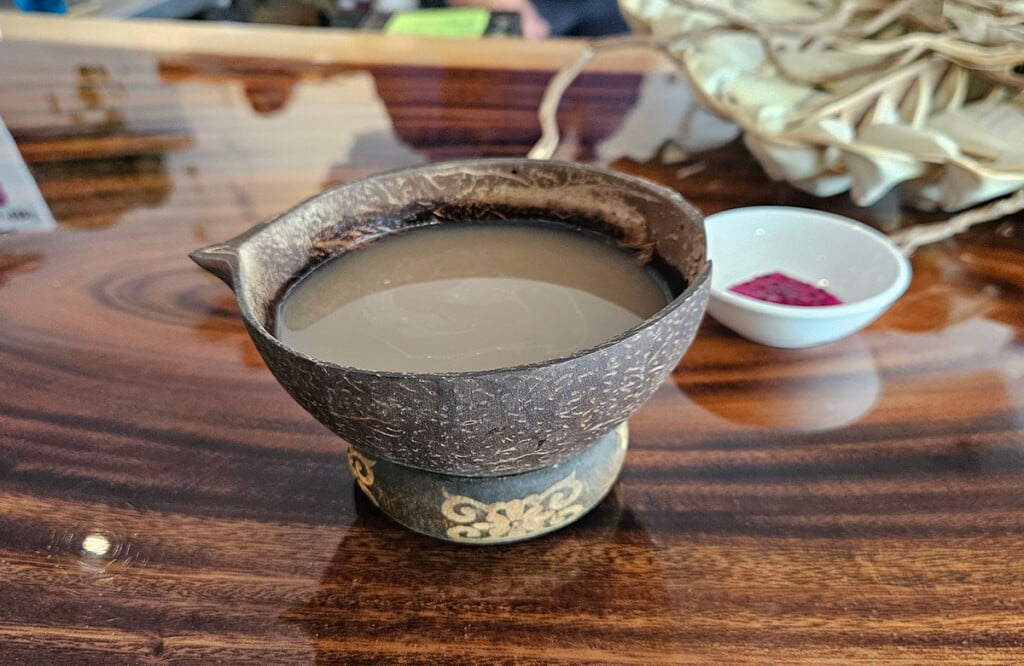This is Your Rare Opportunity to See “Dead Indian Stories”
You have until Oct. 16 to see the new exhibit.
Editor’s Note: Through our partnership with the Honolulu Museum of Art, HONOLULU Magazine publishes a monthly blog written by Lesa Griffith, the museum’s communications director and a talented Hawai‘i writer on arts, culture and food.

Artist Edgar Heap of Birds with prints from his series Dead Indian Stories at the Honolulu Museum of Art.
Photos: Lesa Griffith
With limited budgets, Honolulu Museum of Art curators often have to be creative when it comes to programming. In October, renowned Oklahoma-based Cheyenne artist Edgar Heap of Birds, scheduled to come to Honolulu for the 14th Annual Hawai‘i International Conference on Education, emailed Vince Hazen, director of the Honolulu Museum of Art School about possibly exhibiting his prints. Hazen passed the opportunity to curator of the Arts of Hawai‘i who in turn passed it to curator of contemporary art James Jensen. Heap of Birds’ offer inspired Jensen to organize an “intervention” in the gallery of the art of the Pacific, Africa and the Americas. His goal: To incorporate contemporary works from these regions among the traditional art from the past, and to allow contemporary indigenous artists to introduce commentary about the effects of colonization and assimilation.
So in October, Jensen emailed Heap of Birds confirming he would be interested in showing a selection of prints from his series Dead Indian Stories. He explained that the intervention would include contemporary work by the Maori artist Brett Graham in the Pacific section, one of Enrique Chagoya’s codex prints in the Latin American section. He added that the museum collection includes “a fairly large drawing/painting on paper by Ho-na-nist-to (Howling Wolf), the Southern Cheyenne warrior who was imprisoned by the U.S. Army in St. Augustine, Florida, in 1875.” For Heap of Birds, that information was pure art kismet. He was very familiar with Howling Wolf—his great great grandfather hung out with him.

A Procession of Southern Cheyenne Warriors by Howling Wolf (1849–1927), painted in the late 1870s.
Now you have a rare opportunity to see a dialogue between two works that were made about 140 years apart, and share so much in history and family. On view in the gallery of the Arts of the Americas are selections from Heap of Birds’ print series Dead Indian Stories. The text-based works are a scathing indictment of crimes committed against Native Americans and hang next to the museum’s mid- to late-1870s painting A Procession of Southern Cheyenne Warriors by Howling Wolf, who became a proficient artist in the Ledger style during his imprisonment.
Heap of Birds, a leader of the Elk Warriors Society, graciously gave a gallery talk to a small group of museum supporters while he was here, and answered questions about his work and his connection to Howling Wolf’s painting.
He said that Howling Wolf’s painting depicts four principle chiefs of the Cheyenne tribe. Two of them are Eagle Head, Howling Wolf's father, and Many Magpies, which later translated to Heap o Birds, then later Heap of Birds—Edgar’s great great grandfather. Following Gen. George Custer’s 1868 massacre of a Cheyenne community living along the Washita River in what is now Oklahoma, the chiefs were incarcerated for fighting against the colonial genocide.

Heap of Birds’ print Indian Still Target refers to the U.S. government using “Geronimo” as a code name for OSama bin Laden. |
“My Cheyenne name is Little Chief, a name I inherited from my uncle Edgar, who inherited it from the first Little Chief—Heap of Birds’ nephew, who was also a Warriors Society member imprisoned in Florida,” said Heap of Birds. “The first Little Chief would have been Howling Wolf's contemporary. The fact that [Howling Wolf's] drawing is here is amazing. It shows that, while other Warriors Society Members died in incarceration, Howling Wolf survived it.”
One of his prints proclaims, “Indian still target Obama bin Laden Geronimo,” the white letters looking like freshly written paint, urgent and anxious, on a red background. It refers to “the fact that the government referred to bin Laden as Geronimo,” explains Heap of Birds. “So when they killed him, Osama said, ‘Geronimo is dead,’ and everyone cheered. Here we are in contemporary life and they choose to nickname a hated terrorist an Apache name. Are we still targets? What about the Apache helicopter and the Tomahawk rocket? These things are so violent, why are they associated with native people?”
Some of the messages on the prints might seem mysterious to viewers. “By leaving it somewhat ambiguous, I’m leaving the door cracked open,” says Heap of Birds. “If I made it too explicit, you could just digest it and eject it—you don’t have to really consider it. I hope that people look at the work and, when they enter it, they can relate it to themselves.”
Dead Indian Stories is on view through Oct. 16.
 Lesa Griffith is director of communications at the Honolulu Museum of Art. Born in Honolulu, one of her early seminal art experiences was at the Honolulu Museum of Art, when on a field trip her high school art history teacher pointed out that the ermine cape in Whistler’s Portrait of Lady Meux was not just a cape—it was visual signage leading viewers’ eyes through the painting.
Lesa Griffith is director of communications at the Honolulu Museum of Art. Born in Honolulu, one of her early seminal art experiences was at the Honolulu Museum of Art, when on a field trip her high school art history teacher pointed out that the ermine cape in Whistler’s Portrait of Lady Meux was not just a cape—it was visual signage leading viewers’ eyes through the painting.








